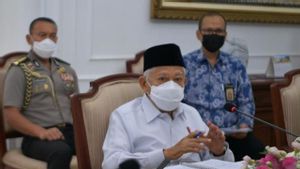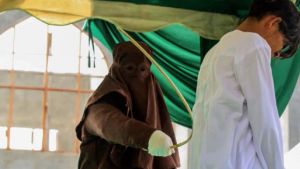SLEMAN - The Regional Disaster Management Agency (BPBD) of Sleman Regency, Yogyakarta Special Region said a number of fallen trees and several billboards in the Kapanewon (Kecamatan) Gamping area collapsed in the rain accompanied by strong winds.
"There were several trees that fell and hit people's houses and blocked road access during the rain and strong winds that hit several villages in Gamping this afternoon at around 13.00 p.m. local time," said Head of Emergency and Logistics Division of BPBD Sleman Makwan, quoted by Antara, Monday, November 1.
He said there were no casualties or injuries in the incident.
"There are several residents' houses that were damaged by falling trees and several access roads that were blocked by tree trunks," he said.
His party has distributed assistance to residents affected by the disaster, both in the form of food and non-food (material) assistance.
"Currently, most of the houses that were hit by trees have been conditioned and tree trunks have been evacuated," he said.
In this incident, the Sleman BPBD attempted to deal with disaster management, such as evacuating tree trunks and opening closed access roads.
"As for further handlings such as cleaning tree trunks and twigs, the authority of other agencies," he said.
Several points where trees fell, namely Banyuraden Village on Jalan Siliwangi Somodaran, RT01/RW10 Banyuraden. The breadfruit tree fell on the house fence and the electric cable, but now it is in good condition.
In addition, on Jalan Wates Balecatur, several billboards/signs were uprooted, covering the Ambarketawang Village in Gamping Kidul RT01/RW18 Ambarketawang, while a fallen tree fell on a resident's house. In Mejing Kidul, Ambarketawang, Gamping, three trees fell on the house fence and there was no damage.
SEE ALSO:
Head of Yogyakarta Sleman Climatology Station, Meteorology, Climatology and Geophysics Agency (BMKG) Reni Kraningtyas asked each region in the Special Region of Yogyakarta (DIY) to increase vigilance regarding the possibility of hydrometeorological disasters occurring in the 2021-2022 rainy season.
Since September III 2021, monitoring of global climate anomalies in the Equatorial Pacific Ocean shows that the ENSO Index (El Nino-Southern Oscillation) shows sea surface temperatures in the central Pacific region have passed the La-Nina threshold with anomaly values on the third basis of September 2021: -0.63°C, first basis October 2021: -0.61°C, second basis October 2021: -0.92°C.
"The October 2021 Enso Index of -0.83°C indicates that ENSO is in a weak La Nina condition. It is predicted that the ENSO La Nina phenomenon is weak and it is possible that a moderate La Nina will last until early 2022," she said.
She said the influence of La Nina in the DIY region had an impact on increasing the intensity of monthly rainfall above its normal or average, at the beginning of the October-November 2021 rainy season it would have a fairly high impact, which was around 60 percent.
"Meanwhile, if La Nina continues until the rainy season (December 2021-January 2022-February 2022), the impact of La Nina will decrease by around 20-60 percent," she said.
Reni said that although the percentage increase in rainfall was relatively smaller, the impact on the increase in hydrometeorological disasters was even higher, especially during the peak of the rainy season, January 2022.
"Especially areas that are prone to flooding and landslides in the DIY region. Stakeholders are expected to be able to anticipate potential hydrometeorological disasters in the DIY region as early as possible," she said.
He appealed to stakeholders to optimally carry out integrated water management from upstream to downstream, by preparing the capacity of rivers and canals to anticipate excessive water discharge.
"The public is advised to continue to update the development of information from the Meteorology Climatology and Geophysics Agency (BMKG) by utilizing the BMKG info social media channel or directly contacting the nearest BMKG office," she said.
The English, Chinese, Japanese, Arabic, and French versions are automatically generated by the AI. So there may still be inaccuracies in translating, please always see Indonesian as our main language. (system supported by DigitalSiber.id)
















